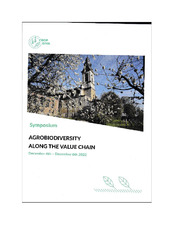Приказ основних података о документу
Evaluation of naked (hulless) barley accessions for future breeding of healthy food barley for Europe
| dc.creator | Dickin, Edward | |
| dc.creator | Roberts, Ashley | |
| dc.creator | Brbaklić, Ljiljana | |
| dc.creator | Jevtić, Radivoje | |
| dc.creator | Vogelgsang, Susanne | |
| dc.creator | Carmenati, Filippo | |
| dc.creator | Hermann, Matthias | |
| dc.creator | Boerner, Andreas | |
| dc.date.accessioned | 2024-03-11T11:54:37Z | |
| dc.date.available | 2024-03-11T11:54:37Z | |
| dc.date.issued | 2023 | |
| dc.identifier.uri | http://fiver.ifvcns.rs/handle/123456789/4332 | |
| dc.description.abstract | Naked (hulless) barley is а type of barley with free-threshing grains that is especially suited for human food. Barley is sadly overlooked as а food |п Europe, despite its health properties, especially beta-glucan soluble fibre, and the barley crop needing lower inputs than wheat and its ability to grow in more marginal conditions expected due to climate change. Due to the small market for seed, пакед barley has not been а рпогку for European plant breeders, but а wide diversity is available т the IPK genebank. CROPDIVA partners tested 300 hulless barley accessions at three sites 1п Serbia, Switzerland and the United Kingdom. Ап augmented design was used with 10 standards - hulled and hulless barley varieties from all three countries апа Germany, each replicated six times within each experimental site. Crop establishment was estimated using Сапорео at 6511, and crop biomass estimated аг GS31 and 6559, also using Canopeo. Disease and lodging were scored, time to 6559 recorded, and grain yield and yield components measured. Post-harvest, beta-glucan concentration гп the grain and the percentage of the grains threshing freely from the hull are the most important traits of interest. Тћеге was а high degree ог phenotypic diversity in crop height, ear type, grain colour etc. Мапу of the accessions were earlier heading, а potentially useful trait to соре with hotter summers. |п the wet conditions in UK many accessions showed high levels ог disease, especially powdery mildew, and there was some yellow rust, а disease rarely seen 1п spring barley due to high levels of resistance in commercial varieties. Yields were lower than the standards, showing the need for breeding to introgress the useful traits observed in this material into new food barley varieties for Europe. | sr |
| dc.language.iso | en | sr |
| dc.relation | info:eu-repo/grantAgreement/EC/RIA/101000847/EU// | sr |
| dc.rights | openAccess | sr |
| dc.rights.uri | https://creativecommons.org/licenses/by/4.0/ | |
| dc.source | (Abstracts), 1st International CROPDIVA Symposium "Agrobiodiversity along the value chain", 4-6 December 2023, Ghent, Belgium | sr |
| dc.subject | naked barley | sr |
| dc.subject | hulless barley | sr |
| dc.subject | accessions | sr |
| dc.subject | breeding | sr |
| dc.subject | healthy food | sr |
| dc.title | Evaluation of naked (hulless) barley accessions for future breeding of healthy food barley for Europe | sr |
| dc.type | conferenceObject | sr |
| dc.rights.license | BY | sr |
| dc.citation.epage | 50 | |
| dc.citation.spage | 50 | |
| dc.identifier.fulltext | http://fiver.ifvcns.rs/bitstream/id/11586/bitstream_11586.pdf | |
| dc.identifier.rcub | https://hdl.handle.net/21.15107/rcub_fiver_4332 | |
| dc.type.version | publishedVersion | sr |


